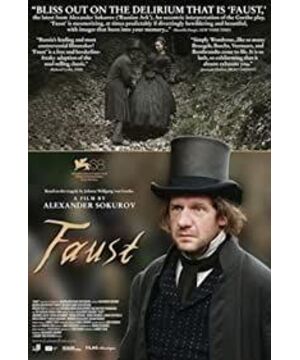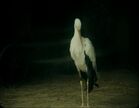In the introduction to the encyclopedia, Sokolov is called "the spiritual successor of Tarkovsky". Although the film has not seen outstanding performance in long shots, the use of metaphors seems to have gone further than the pioneer, which shows that the praise is well-deserved. . Sokolov is one of the few film directors who has been highly appraised by my literature teacher. To be regarded as an outstanding director by this contemporary master who has read countless films is undoubtedly an uncrowned reputation. In my heart It is also the most powerful endorsement of Sokolov's level. What quality of the film might the sophisticated profiler be attracted to? In order to get closer to the art itself, I was eager to guess the answer to this question when I watched the work, but before it was verified, it greatly increased my troubles. Uncontrollably also attracted to something - I can't judge whether it's better or better. In Faust, the concept mentioned in the dialogue between the devil and Faust for the first time I think is one of the highlights of the film: after denying the value of life and death, the devil tells the confused floating Shide (so what is valuable?), the value lies in both time and art. Sokolov has worked hard on both of these areas of Faust's performance, and I'm amazed by the results. "There are some films that can make people re-understand the film, and this film is on the list." This is the chairman of the Venice Film Festival jury Aronofsky commented that "Faust" won the 68th Venice Film Festival in 2011. Forgive me for the rhetoric at the Golden Lion Awards, I can only go so far as to the high connotation of this film.
In my opinion, dialogues and situational metaphors with scattered shapes and meanings are Sokolov's main means of expressing the film's intentions. Color, light, depth of field, lens language and dialogue language together constitute the film's tension. At the same time, we should note that, although the sequence of the whole story neutralizes the jumping, and greatly reduces the difficulty of understanding the surface content of the film, the plot itself is not the fascinating part of this "Faust", and the Soxhlet film cannot also There is no need to be a faithful replicator of Goethe or Thomas Mann's philosophy. So, can we think that the content of the film is closer to the original version of Faust's story, based on the director's use of German and his faithfulness to the atmosphere of the German villages and towns in the late Middle Ages? Perhaps so, perhaps Sokolov is trying to describe the fruit of the post-Faust process of German thought by presenting this motif that inspired the whole world after it was created by German folklore (otherwise, who's philosophical thinking? guided this work?), burrowing subtly into subtopics such as the German nationality he admired. But in any case, when watching the 2011 edition of Faust, the audience should focus not on the story of Faust, but on Sokolov himself.
The mandrake roots that symbolize the human body, the pure and shining pubic hair of Margaret, the power of the fountain and the lake, the devil's treasury full of cobwebs and grit... From the beginning (it is a wilting and ugly male genitalia) , appearing rudely), followed by details that embody the film’s philosophy, all of which ultimately point to an unclear place—the “afterlife” to which Faust finally went after burying the devil (“Where are you going? Where?" "Over there! Farther!"). In a closed narrative environment, the high-density metaphor of the human world, and even a strong alienation color, is a major feature of the film. Or, the latter is the cause, and the former is the effect? "Indecipherable" is the evaluation of the film by many viewers who have read Goethe's poems, and this kind of alienation is the embodiment of Sokolov's personality. Except for a few amazing surreal scenes, the background of the characters in the film seems to be more limited than Goethe's first version of traveling around the world, but it creates a different atmosphere (let's call it "alienation") It goes far beyond the expressive scope of the original story.
It is reflected in the extraordinary background of the overall background, the cramped wandering and the interfering metaphors that always exist in the dialogue of the characters, and the alienation elements are everywhere in this film. In addition, some of the miraculous images have gone beyond "alienation" and become the singularity itself, providing many wonderful moments for my memory - Margaret lying on the bed, golden pubic hair, white carcass, Jade muscle transparent. Faust buried his head in her hair in a gesture of oral sex, and climbed up with his hands. The holiness of Margaret's body amazes me, but don't forget what the world is like outside the two of them (the window is full of ghosts, and the other bed is a dead mother, even with spider webs) also shaky). The same hair-to-hair scene was seen in Faust's father's hospital. In another scene, Faust sold himself to the devil with blood as a pact, and then the ghost passed through the long tunnel, leaving the oil lamp behind, reaching the transparent water surface, saw Margaret standing on the rock beside the water, and then floated Shide hugged her from behind, and the two poured into the lake. In the distant view, the water surface produced circular ripples, and the redemption was completed.
Leaving aside for a moment the beauty that the mysterious tones of the film provide, the symbol of beauty does exist in Faust, with the image of Margaret as the vehicle (the actress is so beautiful). In the above mysterious and pure scene, Gretchen has left the plot of German ballads and became Beatrice, Laura, Lotte, and Salome, that is, the noumenon of beauty. I'm sure each of Margaret's frowns is worth scrutinizing when exploring the artistic thrust of Faust.
Sokolov used the camera to tell the audience that the mysteries of the universe will be permanently hidden in the voices of women. What does Yiren's twisted expression mean? I can't explain it rashly, but it is difficult for the audience to see her age from this face, whether she is an old woman or a bad baby. When she had sinful joy on her face; her cheeks flushed lightly; she walked with downcast eyes; she shunned lustful glances, she had crossed time, and the self-righteous pioneers of mankind were left with confusion.
View more about Faust reviews











